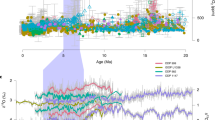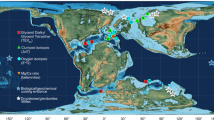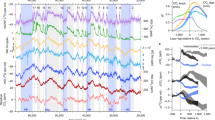Abstract
The Palaeocene–Eocene Thermal Maximum (about 55 Myr ago) represents a possible analogue for the future and thus may provide insight into climate system sensitivity and feedbacks1,2. The key feature of this event is the release of a large mass of 13C-depleted carbon into the carbon reservoirs at the Earth’s surface, although the source remains an open issue3,4. Concurrently, global surface temperatures rose by 5–9 ∘C within a few thousand years5,6,7,8,9. Here we use published palaeorecords of deep-sea carbonate dissolution10,11,12,13,14 and stable carbon isotope composition10,15,16,17 along with a carbon cycle model to constrain the initial carbon pulse to a magnitude of 3,000 Pg C or less, with an isotopic composition lighter than −50‰. As a result, atmospheric carbon dioxide concentrations increased during the main event by less than about 70% compared with pre-event levels. At accepted values for the climate sensitivity to a doubling of the atmospheric CO2 concentration1, this rise in CO2 can explain only between 1 and 3.5 ∘C of the warming inferred from proxy records. We conclude that in addition to direct CO2 forcing, other processes and/or feedbacks that are hitherto unknown must have caused a substantial portion of the warming during the Palaeocene–Eocene Thermal Maximum. Once these processes have been identified, their potential effect on future climate change needs to be taken into account.
This is a preview of subscription content, access via your institution
Access options
Subscribe to this journal
Receive 12 print issues and online access
$259.00 per year
only $21.58 per issue
Buy this article
- Purchase on Springer Link
- Instant access to full article PDF
Prices may be subject to local taxes which are calculated during checkout




Similar content being viewed by others
References
IPCC. Climate Change 2007: The Physical Science Basis (eds Solomon, S., et al.) (Cambridge Univ. Press, 2007).
Zachos, J. C., Dickens, G. R. & Zeebe, R. E. An early Cenozoic perspective on greenhouse warming and carbon-cycle dynamics. Nature 451, 279–283 (2008).
Dickens, G. R. Methane oxidation during the late Palaeocene Thermal Maximum. Bull. Soc. Geol. Fr. 171, 37–49 (2000).
Pagani, M., Calderia, K., Archer, D. & Zachos, J. C. An ancient carbon mystery. Science 314, 1556–1557 (2006).
Kennett, J. P. & Stott, L. D. Abrupt deep-sea warming, palaeoceanographic changes and benthic extinctions at the end of the Palaeocene. Nature 353, 225–229 (1991).
Zachos, J. C. et al. A transient rise in tropical sea surface temperature during the Paleocene–Eocene Thermal Maximum. Science 302, 1551–1554 (2003).
Tripati, A. & Elderfield, H. Deep-sea temperature and circulation changes at the Paleocene–Eocene Thermal Maximum. Science 308, 1894–1898 (2005).
Zachos, J. C. et al. Extreme warming of mid-latitude coastal ocean during the Paleocene–Eocene Thermal Maximum: Inferences from TEX86 and isotope data. Geology 34, 737–740 (2006).
Sluijs, A. et al. Subtropical Arctic Ocean temperatures during the Palaeocene/Eocene Thermal Maximum. Nature 441, 610–613 (2006).
Zachos, J. C. et al. Rapid acidification of the ocean during the Paleocene–Eocene Thermal Maximum. Science 308, 1611–1615 (2005).
Lyle, M., Wilson, P. A. & Janecek, T. R. Leg 199 summary. Proc. ODP Init. Rep. 199, 1–87 (2002).
Farley, K. A. & Eltgroth, S. F. An alternative age model for the Paleocene–Eocene Thermal Maximum using extraterrestrial 3He. Earth Planet Sci. Lett. 208, 135–148 (2003).
Colosimo, A. B., Bralower, T. J. & Zachos, J. C. in Proc. ODP, Sci. Results Vol. 198 (eds Bralower, T. J., Premoli Silva, I. & Malone, M. J.) (Texas A&M Univ., 2005).
Murphy, B., Lyle, M. & Lyle, A. O. in Proc. ODP, Sci. Res. (eds Wilson, P. A., Lyle, M. & Firth, J. V.) 1–12 (Texas A&M Univ., 2006).
Thomas, D. J. et al. Warming the fuel for the fire: Evidence for the thermal dissociation of methane hydrate during the Paleocene–Eocene Thermal Maximum. Geology 30, 1067–1070 (2002).
Nunes, F. & Norris, R. D. Abrupt reversal in ocean overturning during the Palaeocene/Eocene warm period. Nature 439, 60–63 (2006).
Röhl, U., Westerhold, T., Bralower, T. J. & Zachos, J. C. On the duration of the Paleocene–Eocene Thermal Maximum (PETM). Geochem. Geophys. Geosyst. 8, Q12002 (2007).
Zeebe, R. E. & Zachos, J. C. Reversed deep-sea carbonate ion basin-gradient during Paleocene–Eocene Thermal Maximum. Paleoceanography 22, PA3201 (2007).
Dickens, G. R., O’Neil, J. R., Rea, D. K. & Owen, R. M. Dissociation of oceanic methane hydrate as a cause of the carbon isotope excursion at the end of the Paleocene. Paleoceanography 10, 965–971 (1995).
Zeebe, R. E., Zachos, J. C., Caldeira, K. & Tyrrell, T. Oceans: Carbon emissions and acidification. Science 321, 51–52 (2008).
Dickens, G. R. Carbon addition and removal during the Late Palaeocene Thermal Maximum: Basic theory with a preliminary treatment of the isotope record at ODP Site 1051, Blake Nose. Geol. Soc. Lond. Spec. Publ. 183, 293–305 (2001).
Bowen, G. J. et al. A humid climate state during the Paleocene–Eocene Thermal Maximum. Nature 432, 495–499 (2004).
van Andel, T. H. Mesozoic/Cenozoic calcite compensation depth and the global distribution of calcareous sediments. Earth Planet. Sci. Lett. 26, 187–194 (1975).
Tyrrell, T. & Zeebe, R. E. History of carbonate ion concentration over the last 100 million years. Geochim. Cosmochim. Acta 68, 3521–3530 (2004).
Panchuk, K., Ridgwell, A. & Kump, L. R. Sedimentary response to Paleocene–Eocene Thermal Maximum carbon release: A model-data comparison. Geology 36, 315–318 (2008).
Bice, K. L. & Marotzke, J. Could changing ocean circulation have destabilized methane hydrate at the Paleocene/Eocene boundary? Paleoceanography 17, 1018 (2002).
Dickens, G. R. Rethinking the global carbon cycle with a large, dynamic and microbially mediated gas hydrate capacitor. Earth Planet. Sci. Lett. 213, 169–183 (2003).
Sloan, L. C. et al. Possible methane-induced polar warming in the early Eocene. Nature 357, 320–322 (1992).
Röhl, U., Bralower, T. J., Norris, R. D. & Wefer, G. New chronology for the late Paleocene thermal maximum and its environmental implications. Geology 28, 927–930 (2000).
Marland, G., Boden, T. A. & Andres, R. J. Global, Regional, and National CO2 Emissions (CDIAC, ORNL, US DOE, 2007).
Acknowledgements
The research was supported by NSF grant EAR06-28719 to J.C.Z. and EAR06-28394 to R.E.Z.
Author information
Authors and Affiliations
Corresponding author
Supplementary information
Supplementary Information
Supplementary Information (PDF 581 kb)
Rights and permissions
About this article
Cite this article
Zeebe, R., Zachos, J. & Dickens, G. Carbon dioxide forcing alone insufficient to explain Palaeocene–Eocene Thermal Maximum warming. Nature Geosci 2, 576–580 (2009). https://doi.org/10.1038/ngeo578
Received:
Accepted:
Published:
Issue Date:
DOI: https://doi.org/10.1038/ngeo578
This article is cited by
-
Intensified continental chemical weathering and carbon-cycle perturbations linked to volcanism during the Triassic–Jurassic transition
Nature Communications (2022)
-
The Eurasian epicontinental sea was an important carbon sink during the Palaeocene-Eocene thermal maximum
Communications Earth & Environment (2022)
-
Intrusions induce global warming before continental flood basalt volcanism
Nature Geoscience (2022)
-
Astrochronology of the Paleocene-Eocene Thermal Maximum on the Atlantic Coastal Plain
Nature Communications (2022)
-
Oceanic anoxic events in the Earth’s geological history and signature of such event in the Paleocene-Eocene Himalayan foreland basin sediment records of NW Himalaya, India
Arabian Journal of Geosciences (2022)



